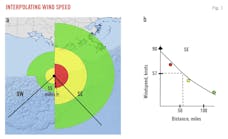Arctic Technology Conference: Arctic JIP outlines research plans
An Arctic Oil Spill Response Technology Joint Industry Program (JIP) will continue building knowledge on Arctic offshore oil spill response expertise already developed through 40 years of research by individual companies and other organizations, speakers told the Arctic Technology Conference Dec. 4.
The International Association of Oil & Gas Producers is providing JIP with project management expertise, and nine oil and gas companies already belong to JIP, which plans a series of advanced research projects on six key areas of research within 10 projects.
Researchers from member companies are involved in technical working groups responsible for individual research projects, said Joe Mullin, JIP program manager.
The members so far are BP PLC, Chevron Corp., ConocoPhillips, Eni SPA, ExxonMobil Corp., North Caspian Operating Co., Royal Dutch Shell PLC, Statoil ASA, and Total SA. Mullin said membership remains open if other companies wish to join.
JIP will research dispersants, in-situ burning, mechanical recovery, remote sensing, trajectory modeling, and the environmental effects of a spill and the associated response activities.
Recently, JIP launched a web site where details of the projects can be found. Reports based on the research will be posted online as the reports are completed, starting next year, Mullin said.
Mullin briefly described the projects to ATC participants. These projects are:
• Fate of dispersed oil under ice. The goal is to develop a numerical model capable of predicting the behavior of a dispersed oil plume under ice with an emphasis on the potential for an oil plume to resurface.
• Dispersion of oil in ice. The project will examine the effectiveness of dispersant used in arctic environments. This will involve large-scale tank research to test the efficacy of dispersants in arctic waters and to determine optimal conditions for dispersion.
• Environmental impacts from arctic oil spills and oil spill response technologies. The project will provide an information base to support the use of net environmental benefit analysis (NEBA) for arctic oil spill environmental impact assessments and response decision-making.
• Oil spill trajectory modeling in ice. This project will develop a numerical model capable of predicting oil trajectory in seas with different ice concentrations.
• Oil spill detection and mapping in low visibility and ice. The project seeks to expand remote sensing and monitoring capabilities in ice-infested waters during periods of darkness and low visibility as well as to detecting and tracking different types of oil in a range of ice and water conditions.
• Mechanical recovery of oil in ice. This project will examine the results obtained from previous research projects to identify and select concepts that can be rigorously examined to improve mechanical recovery under arctic conditions and bring the concepts to the proof of concept stage.
• In-situ burning (ISB) of oil in arctic environments. ISB is the focus of three projects. Project 7 seeks to better understand the degree to which ISB can be used effectively as a response technique in arctic conditions and to raise awareness of the pros and cons of ISB. BP is chairing the project. Projects 8 and 9 will focus on aerial ignition systems for ISB in specific arctic ice environments.
• Field research. This project will provide support to the research by developing and coordinating field scenarios to verify technologies and methodologies developed through the Arctic JIP. Controlled field research might be done on one or more of the projects that researchers determine cannot effectively progress without testing in an arctic environment.
Contact Paula Dittrick at [email protected].

Paula Dittrick | Senior Staff Writer
Paula Dittrick has covered oil and gas from Houston for more than 20 years. Starting in May 2007, she developed a health, safety, and environment beat for Oil & Gas Journal. Dittrick is familiar with the industry’s financial aspects. She also monitors issues associated with carbon sequestration and renewable energy.
Dittrick joined OGJ in February 2001. Previously, she worked for Dow Jones and United Press International. She began writing about oil and gas as UPI’s West Texas bureau chief during the 1980s. She earned a Bachelor’s of Science degree in journalism from the University of Nebraska in 1974.
